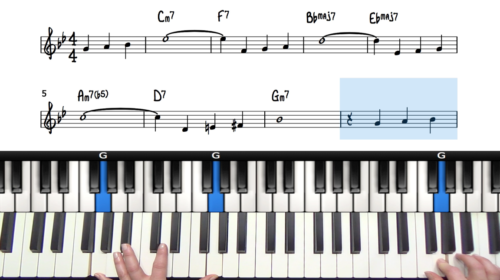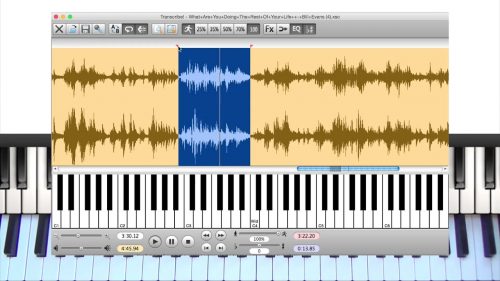Summertime Improvisation Tutorial
In part 1 of this tutorial, we played through the form with left hand voicings to familiarise ourselves with the melody and chord changes. We then added in some bigger voicings and passing chords to create a fuller and more interesting sounding arrangement.
In part 2 of this tutorial we analyse a section of an improvised solo over the tune ‘Summertime’. We explore how you can use transcription to develop your sense of swing and swing feel.
From just 10 bars of transcribed material, we explore and discuss the following topics:
-
Starting the line on the & of 3 and accenting the first beat
-
Incorporating triplets into improvised lines
-
Improvising with the notes of the blues scale
-
Infusing the blues scale with other modal scales
-
Outlining triad shape shapes in improvised lines
-
Building lines exclusively of chord tones over dominant chords
- Developing a strong swing feel
The lesson downloads for this tutorial include the chord changes and a transcription of the start of the improvised solo. You can also download a midi and audio file of the arrangement.
Transcription Exercise
This lesson has a related transcription exercise which can be found in the PianoGroove forum. Here’s a direct link to the transcription exercise forum thread: https://pianogroove.com/community/t/transcription-exercises/147/2
Practice Tips
-
Transcription is the key to learning how to improvise.
-
The more lines and solos you transcribe, the more ideas you will have when you come to improvise... Think about it, where else are the ideas and inspiration going to come from?
-
When you come to improvise, you do not simply pull ideas out of thin air. You are calling on your library of sounds, shapes, and lines that you have built up over the years through listening and transcribing.
-
You have to have heard it before and then absorbed it through transcription so that it comes out almost subconsciously when you want to improvise.
- When we are babies, we learn to speak by listening and copying our parents speak... as babies we know this is the most effective way to learn. You should approach jazz piano improvisation in exactly the same way.







Thanks Hayden, I found this incredibly useful. Apropos my recent question about constructing jazz solos you emphasised the importance of transcription. And yes I’m finding it really difficult. My point is, giving the example from this lesson I feel this gives me a form and structure to work from. I can’t read music and play entirely by ear. I think I said to you that having played blues and some jazz/blues for most of my piano playing experience i can hear the blues form when I solo in my head before approaching each change. But I struggle with the jazz solo form. It’s doesn’t come naturally. This lesson highlights an example of what I think I was asking for. Yes it’s still a bluesy form, but the use of chord tones and other scales i found very useful. The new transcription idea you’re developing is exactly what I was alluding to in my question about constructing a jazz solo, so well done again and thanks. I’ve purchased the transcription app you recommended.
I must be getting better because the ‘misses’ keeps commenting on how much she enjoys listening to the ‘new’ music I’m playing all the time. Ha!
Cheers mate and thanks again,
Eric
Hi Eric, that’s great to hear… and yes it fits in with many questions I’ve been getting recently so hopefully it will give students some additional inspiration to dabble with transcription.
I think this would be a really nice tune for you to work on with transcription, firstly because it’s only 16 bars long so it’s similar to the 12 bar blues which you are already very familiar with.
Next it has lots of the minor 251s in A Minor and so this will help you develop more ‘jazz vocabulary’ as appose to just playing over dominant chords like in a simple 12 bar blues.
There is also many, many recordings of this tune so plenty of solos to transcribe from!
Chord tones are extremely important Eric… we are going to explore this with the upcoming study on the blues and look at creating a full improv with chord tones – this doesn’t always sound great, but when you sparingly add in an alteration or extension (like in this example with the b9) it sounds colourful yet still very consonant.
Awesome I’m glad you’re on-board with the transcription initiative… and yes Transcribe is a wonderful program. There is rarely a day when it is not open on my computer!
Great news with the progress you’re making – it makes me happy to hear that mate.
Cheers,
Hayden
Cheers Hayden, I’ll take your advice (as usual) and learn Summertime in the context you recommend. I’ve learned quite a few tunes to play so that I don’t get bored playing the same two tunes I’m using to study in depth to learn the theory component of my jazz learning. I’ll add Summertime to the in depth theory component, especially in the context of transcription and soloing.
Cheers mate,
Eric
I’m staying on this tune for a while. ….since the form is simple and exploring what people do with it…. found a cool video on 2feel….
. Giving me some additional stuff to try. I’m having fun.
Awesome thanks for sharing Lori…. I’ve come across Aimee’s YouTube channel before, she’s a very talented musician and has some wonderful videos and insights.
It would be nice to create a forum thread that highlights other channels and online educators… I always tell my students to try to study with multiple teachers if possible as it’s nice to get multiple views and opinions when studying jazz… the subject is so vast!
Yes “Summertime” is a great tune to work on, it’s a short form so it’s easy to get familiar with. It also contains a number of minor 251s so it’s perfect for working out ways to navigate that common progression.
The 12 Bar Blues Series is very close to completion, I’m currently editing the final few videos. There’s 9 lessons in total which cover the blues form, jazz blues form and other 7 are dedicated to improvisation concepts. Then finally the first blues standard tutorial on “Straight No Chaser” where we apply the concepts to a tune.
All of the concepts I cover will be applicable to this tune and any others you are working on.
I’m excited to launch this new section of the website and it will really help the students looking to develop their improvisation skills.
I hope your jam sessions have gone smoothly so far – “Summertime” is always a nice tune to call… particularly if a vocalist shows up! ;-)
Cheers,
Hayden
Transcription is very difficult for me. Can you recommend some swinging solos that are approachable? For example, can you reference the recording of summertime you used for this lesson. Other suggestions of things to transcribe that are on the easier side>
Hi Charles,
I’d recommend starting on 12 Bar Blues recordings. The form is simple to follow and the riffs are often repetitive. This is good to understand how to develop motifs and themes.
Here’s a couple of recordings I’m currently working on transcribing: pianogroove.com/community/t/wynton-kelly-recordings/1763
Follow these steps:
1) Listen to the recording for days before even starting to transcribe
2) Play along with the record in your left hand to follow the form
3) Pay attention to where the improvised lines start and end – count along to keep track of this.
4) Notice how the motifs/melodic material often changes when the form repeats
5) Pay attention to the turnaround (last 2 bars of the form) and how this propels into the next
Wynton is swingin’ – just listening to him will improve your sense of swing.
Emulate his phrasing, over and over.
Pick one of those records and any other questions let me know.
Enjoy this journey – it’s really good fun!
Cheers,
Hayden